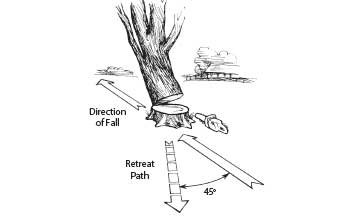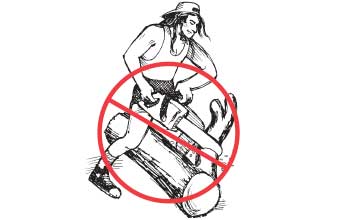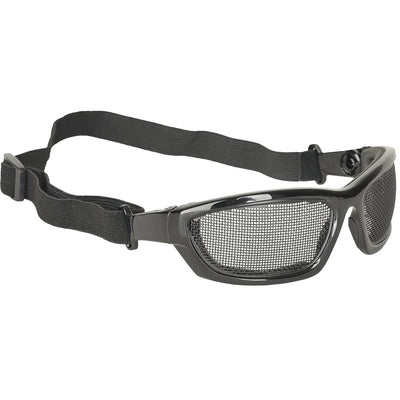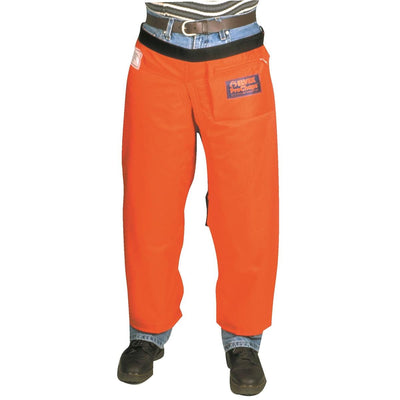Work Safely With Chain Saws
Here are some key points.
- Carefully read the manufacturer’s instructions before you use a chain saw.
- Always wear protective equipment.
- Be on the alert for kickback when you are sawing.
Chain saws can be dangerous
- Chain saws can save you a lot of time and work. But they are potentially dangerous.
- Many chain saw accidents happen because users don’t understand the saw’s hazards, or don’t carefully follow the manufacturer’s instructions.
- One of the biggest hazards of chain saws is kickback. This often occurs when the nose or tip of the guide bar comes into contact with an object such as a rock, log or branch. The guide bar abruptly kicks up and back toward the operator – causing the person to lose control of the saw.

Check your clothing. Don’t operate a chain saw while wearing loose fitting clothing, jewelry, a scarf, cuffed pants or anything else that could become entangled in the saw. Tie long hair back.

Be alert for springback when cutting a limb under tension so you aren’t struck when the tension in the wood fibers is released.

Wear the proper protective equipment. This should include heavy duty gloves with a good grip; sturdy shoes or boots with nonslip soles; head, eye and hearing protection; and leg protection such as chain saw chaps.
Before you begin the job
- Become familiar with the chain saw you will be using and its safety features.
- These are the chain saws we use here.
- Carefully review the manufacturer’s instructions. If you don’t understand them, talk to your supervisor.
- Be sure you are in good physical condition. If you are overtired or for any other reason feel you can’t do strenuous work, see your supervisor.
- Check your clothing. Don’t operate a chain saw while wearing loose fitting clothing, jewelry, a scarf, cuffed pants or anything else that could become entangled in the saw. Tie long hair back.
- Wear the proper protective equipment. This should include heavy duty gloves with a good grip; sturdy shoes or boots with nonslip soles; head, eye and hearing protection; and leg protection such as chain saw chaps.
Check the area around you
Make sure that:
- there are no people or animals in the immediate area
- the ground is free of obstacles such as rocks, stumps, holes, and wet or otherwise slippery brush
- you can get a firm footing on the ground
- you know which way the tree will fall if you are felling a tree, and you have a safe way out of the area
Reduce the chances of kickback
- Get a firm grip on the saw with both hands and plant both feet firmly on the ground.
- Keep an eye on the tip of the guide bar to make sure it doesn’t come into contact with another object.
- Saw below shoulder height, and don’t overreach.
- Saw with the engine on full throttle.
- Don’t cut with the nose or tip of the guide bar.
- Stand slightly to the left of the guide bar – not directly behind the saw.
Other safety tips
- Be sure your saw is in good working condition at all times. The chain should be sharp and the tension properly adjusted.
- Don’t remove the chain saw’s safety equipment.
- Turn the engine off before you put your saw down or carry it.
- Don’t cut with the saw between your legs or straddle the limb you will be cutting.
- Be alert for springback when cutting a limb under tension so you aren’t struck when the tension in the wood fibers is released.
- Keep the saw and its handles clean and dry.
- Wipe up spilled fuel and oil after refueling.
- Properly maintain the saw and its safety equipment.
- Don’t try to repair a chain saw yourself. It takes trained chain saw service personnel.
Chainsaw Safety Do’s and Don’ts
Do
- Carefully review the manufacturer’s instructions before using a chain saw.
- Only operate a chain saw in well-ventilated areas.
- Wear the proper protective equipment.
- Operate a chain saw that appears damaged or in disrepair.
- Saw near flammable liquids or gasses.
- Ever remove a chain saw’s safety equipment.
Chainsaw Clothing & Accessories
When you’re ready to work safely, you’re ready to work. See our full line of safety supplies, including respirators, eye and ear protection, coveralls, first aid and more.










